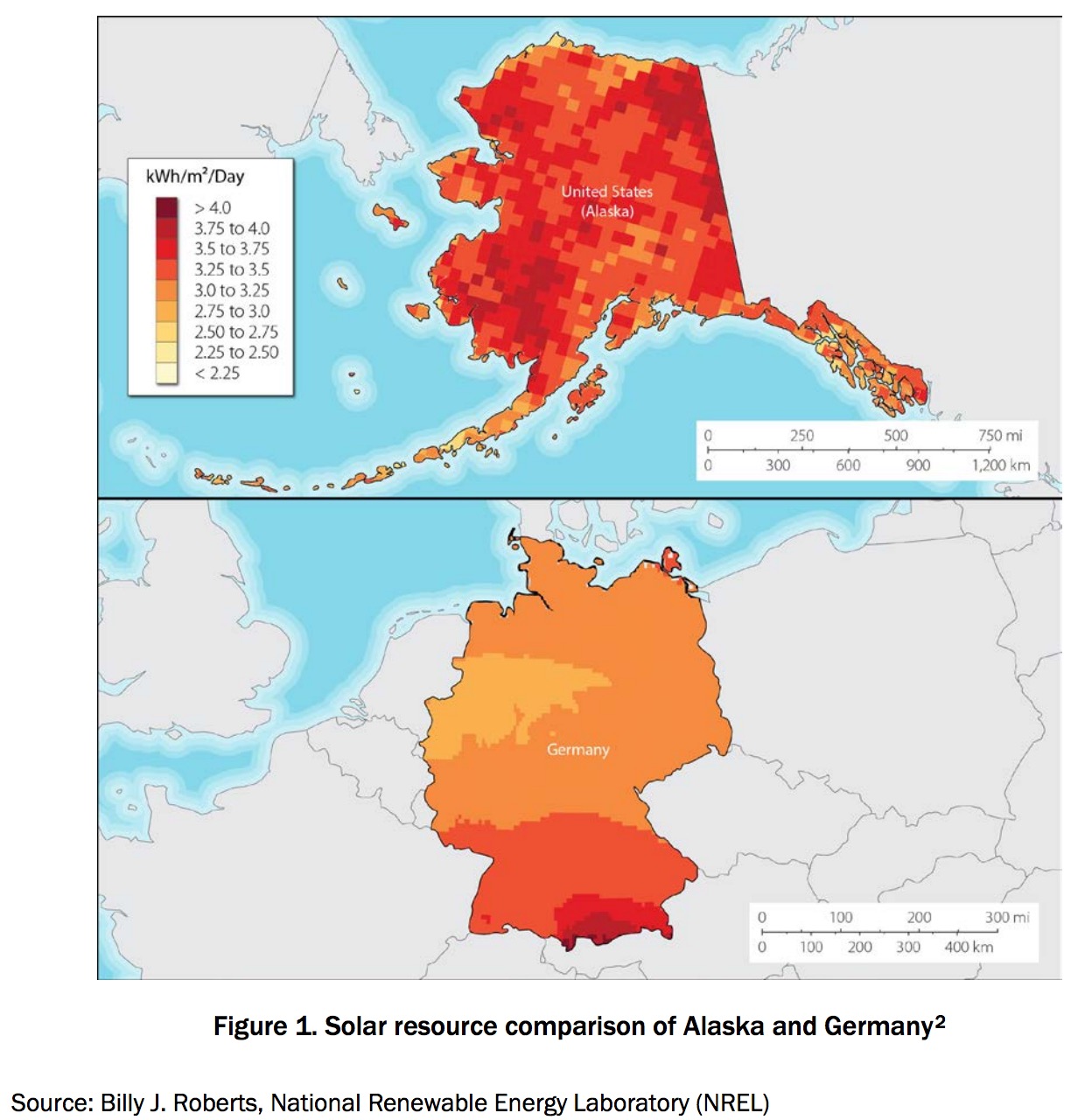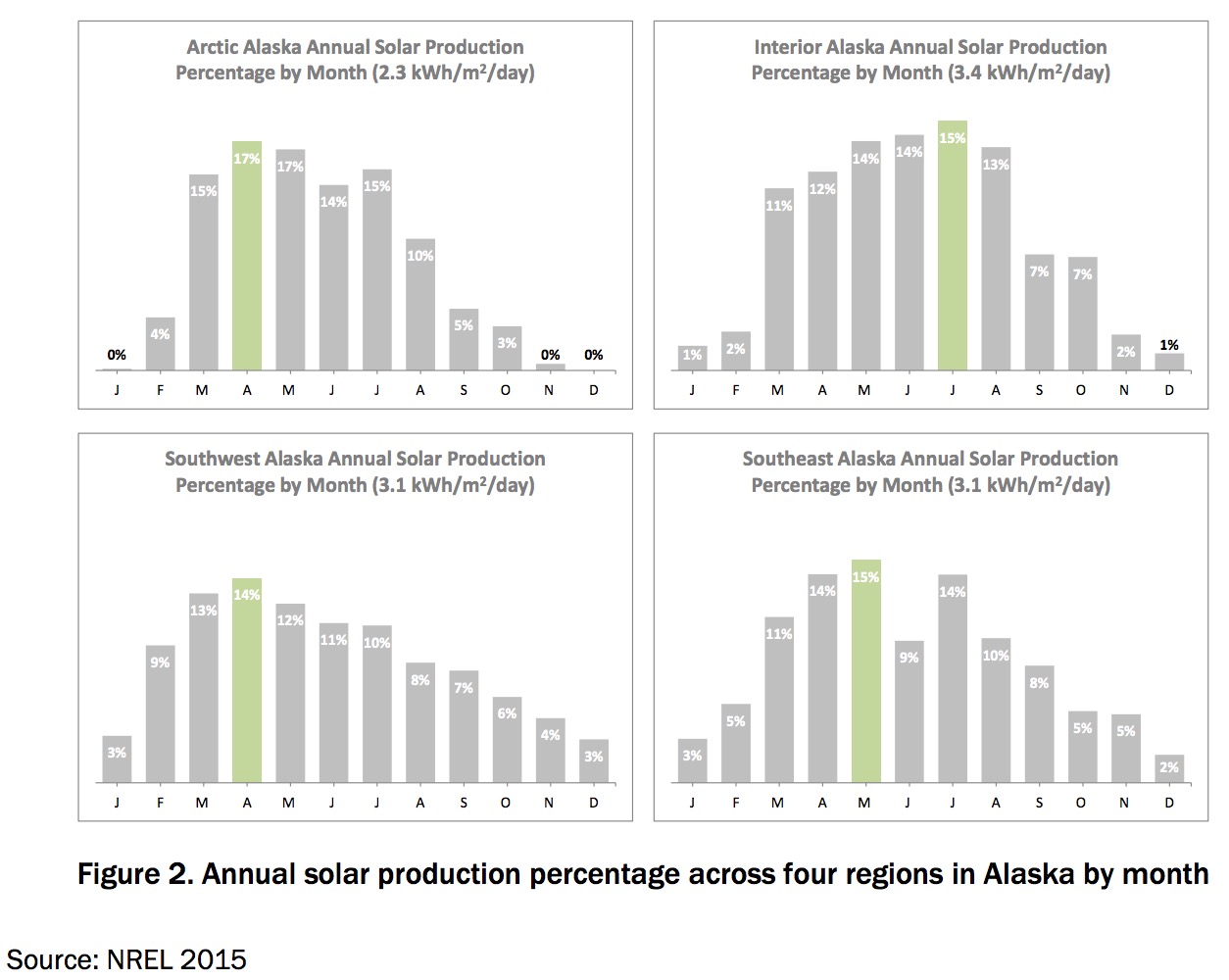UNITED STATES DEPARTMENT OF ENERGY
An Economic Analysis of Solar Photovoltaics in the Last Frontier State
By Paul Schwabe, National Renewable Energy Laboratory
Introduction
Exploitation and utilization of energy resources within the state of Alaska has predominantly and historically centered on its abundance of fossil-fuel deposits including oil, natural gas, and coal. Within the last decade, however, renewable energy technologies have been deployed across the state for both demonstration purposes and commercial ventures (REAP 2016). This diversification of energy sources has been driven from at least three primary factors: (1) the economic exposure of many Alaskan communities to oil price fluctuations and other petroleum market influences (2) technological advancements and reductions in the cost of renewable energy equipment, and (3) efforts to improve self-sufficiency for remote Alaskan communities. Due to these factors and more, renewable energy resources are increasingly being considered to meet Alaska’s energy needs (Foster et al. 2013).
Renewable energy technologies used in Alaska have included small and large hydroelectric facilities, utility-scale and distributed wind generation, geothermal and air heat pumps, and woody biomass for electricity and heating (REAP 2016, CCHRC 2016). In addition to these endemic natural resources, a previously dismissed but pervasive form of renewable energy is also increasingly being analyzed and deployed in Alaska: solar electricity generated from photovoltaic (PV) panels.
The lack of historical solar energy development in Alaska is due to a multitude of factors, but not surprisingly starts with one fundamental problem: minimal to no sunlight in the winter months, particularly for the northern latitudes. Of course, Alaska also experiences prolonged and sunlight rich summer days, but many of the biggest energy needs arise during the cold and dark months of winter. Despite this seemingly obvious barrier for solar electricity in Alaska, upon deeper examination there are several factors that may support the deployment of solar energy in particular locations across the state.
First, Alaska is an immense state with a large geographic range along both the north-to-south and east-to-west directions. Many Alaskans will proudly and dryly note that if one was to hypothetically cut the state into two, Texas would be only the third largest state in the Union. This expansive and diverse geographic range means that there are significant differences in both the amount and seasonal variation of the solar resource across the state. Additionally many of the meteorological conditions experienced in certain regions of Alaska can actually be beneficial to solar energy production, including low ambient temperatures that improve the efficiency of solar modules and the reflectivity of sunlight off of snow cover on the ground. As shown in Figure 1, the solar resource (i.e., the amount of solar insolation received in kilowatt-hours (kWh)/square meters (m2)/day) in some regions of Alaska is at-least comparable to that of Germany, which leads the world in PV installations with more than 38,500 megawatts (MW) of solar installed as of October 2015 (Wirth 2015).
Second, both the expected monthly solar production and the seasonal load profile of communities can vary significantly across Alaska, meaning some communities may be better suited for solar production than others. Figure 2 shows the percentage of expected annual solar production by month across the Arctic, Interior, Southwest, and Southeast geographic regions of Alaska. 3 The Arctic and Interior regions of Alaska could expect high solar production predominantly from March through August, with a steep drop off in the shoulder months and little to no production in the winter. The Southeast and Southwest regions of Alaska show a more gradual transition of solar production levels from the sunlight rich spring and summer months to the shortening days of fall and winter. Although the electricity load peaks for many Alaska Native villages in the winter months when solar is minimally producing, these villages are also often running primarily on diesel-based generation during summer months for basic electricity needs such as lighting, refrigeration, cooking, and electronics when solar PV energy could offset fossil-fuel consumption. Furthermore, despite the cold and dark winters in Alaska that result in high energy demands, some Alaska communities have summer-peaking energy demands primarily because of commercial fishing activities and higher seasonal populations in the summer, which is generally compatible with solar availability.
Lastly, and perhaps most significantly, Alaska has more than 175 remote village populations that rely almost exclusively on diesel fuel for electricity generation and heating oil for heat (Goldsmith 2008, AEA 2014a). Although oil is extracted in the North Slope of Alaska, the in-state production does not result in a below market price for oil within the state. Chris Rose, Renewable Energy Alaska Project Executive Director notes, “We [Alaskans] pay the world commodity oil price. We’ve never received some sort of ‘hometown’ discount for oil.” (Gerdes 2015). Unprocessed crude oil extracted within the state is transported via the TransAlaska pipeline from the North Slope to refineries in the Interior and South-Central regions of Alaska and then delivered locally as diesel and gasoline to rural communities a few times per year. Most fuel deliveries to remote communities are made via barge, ice road, or air transport, which also contributes to the high local prices for diesel and gasoline.5 The local markup to retail pricing also adds to the “all-in” prices for fuel in rural villages. Due to these and other factors, electricity generated by diesel fuel in some rural communities can be $1.00/kilowatt-hour (kWh) or more, which is more than 8 times the national average of $0.12/kWh (AEA 2014a, EIA 2014). As described later in this report, the State of Alaska has enacted various programs for both renewable and diesel energy sources to help reduce the energy costs in rural Alaska, but many of these programs are limited to certain sectors, or are increasingly under scrutiny with the budget difficulties being experienced by the state (AEA 2016a, AEA 2016b, Johnson 2015).
For these reasons and more, alternative forms of electricity generation including solar PV are increasingly being pursued in remote Alaska communities (see Figure 3 for examples of solar PV recently installed in the Northwest Arctic Borough). This analysis provides a high-level examination of the potential economics of solar energy in rural Alaska across a geographically diverse sample of remote villages throughout the state. It analyzes at a high level what combination of diesel fuel prices, solar resource quality, and PV system costs could lead to an economically competitive moderate-scale PV installation at a remote village. The goal of this analysis is to provide a baseline economic assessment to highlight the possible economic opportunities for solar PV in rural Alaska for both the public and private sectors.
Download full version (PDF): Solar Energy Prospecting in Remote Alaska
About the United States Department of Energy
energy.gov
The mission of the Energy Department is to ensure America’s security and prosperity by addressing its energy, environmental and nuclear challenges through transformative science and technology solutions.
Tags: AK, Alaska, Department of Indian Energy, Solar Energy, U.S. DOE, United States Department of Energy








 RSS Feed
RSS Feed